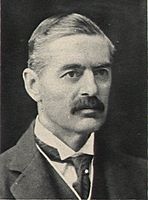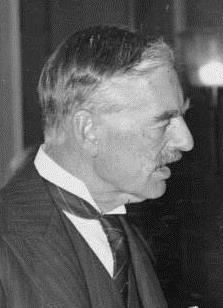National Government (1937–1939) facts for kids
Quick facts for kids National Government |
|
|---|---|
4th National Government of the United Kingdom |
|
| 1937–1939 | |

Neville Chamberlain
|
|
| Date formed | 28 May 1937 |
| Date dissolved | 3 September 1939 |
| People and organisations | |
| Monarch | George VI |
| Prime Minister | Neville Chamberlain |
| Prime Minister's history | 1937–1940 |
| Total no. of members | 119 appointments |
| Member parties |
|
| Status in legislature | Majority (coalition)
428 / 615 (70%)
|
| Opposition party | Labour Party |
| Opposition leaders |
|
| History | |
| Legislature term(s) | 37th UK Parliament |
| Predecessor | Third National Government |
| Successor | Chamberlain war ministry |
The National Government of 1937–1939 was a special kind of government in the United Kingdom. It was led by Neville Chamberlain, who became the Prime Minister of the United Kingdom in May 1937. He took over from Stanley Baldwin after King George VI's coronation.
This government was called a National Government because it included members from different political parties. These were the Conservative Party, the Liberal Nationals, and National Labour. It also had some people who didn't belong to any party. In September 1939, as Nazi Germany started World War II, Chamberlain changed his government to better handle the war.
| Top - 0-9 A B C D E F G H I J K L M N O P Q R S T U V W X Y Z |
What Was the National Government?
This government was formed when Neville Chamberlain became Prime Minister. It was a mix of different political groups working together. This was common in times of national crisis or when no single party had a clear majority.
The main goal of this government was to lead Britain during a very uncertain time. Europe was facing growing threats from Nazi Germany. The government had to prepare the country for possible war while also trying to keep peace.
Key Policies and Decisions
Chamberlain's government focused on two main areas: dealing with other countries (foreign policy) and improving life at home (domestic policy).
Foreign Policy: Dealing with Hitler
Neville Chamberlain is most famous for his policy of appeasement. This meant trying to avoid war by giving in to some of Hitler's demands. A key example was the Munich Agreement in 1938. In this agreement, Britain and France allowed Germany to take over a part of Czechoslovakia called the Sudetenland.
Chamberlain believed this agreement brought "peace in our time." Many people at the time supported him. However, his government also started to increase Britain's military strength, known as rearmament. They worked closely with France to prepare for what might come.
When Hitler continued his aggressive actions in 1939, taking over the rest of Czechoslovakia and threatening Poland, Chamberlain changed his approach. Britain promised to defend Poland if Germany attacked. When Germany invaded Poland in September 1939, Britain and France declared war.
Domestic Policies: Improving Life at Home
Chamberlain also wanted to make life better for people in Britain. He passed several important laws:
- The Factories Act 1937 aimed to improve working conditions in factories. It also set limits on how many hours women and children could work.
- The Coal Act 1938 allowed the government to take control of coal deposits. This meant the government, not private companies, owned the coal underground.
- The Holidays with Pay Act 1938 gave many workers the right to paid holidays for the first time.
- The Housing Act 1938 provided money to help clear slums (poor, crowded housing areas). It also kept rent control in place to help people afford homes.
Chamberlain had more plans, like raising the school-leaving age to 15. However, these plans had to be put on hold when World War II began in 1939.
Who Was in the Cabinet?
The Cabinet is a group of the most important ministers who help the Prime Minister make big decisions. Here are some of the key people in Chamberlain's Cabinet from May 1937 to September 1939:
- Neville Chamberlain – The Prime Minister and leader of the House of Commons.
- The Viscount Hailsham – The Lord High Chancellor, a top legal officer.
- The Viscount Halifax – The Lord President of the Council and leader of the House of Lords.
- Sir John Simon – The Chancellor of the Exchequer, in charge of the country's money.
- Sir Samuel Hoare – The Secretary of State for the Home Department, in charge of internal affairs.
- Anthony Eden – The Secretary of State for Foreign Affairs, dealing with other countries.
- Leslie Hore-Belisha – The Secretary of State for War, in charge of the army.
- Duff Cooper – The First Lord of the Admiralty, in charge of the navy.
- Oliver Stanley – The President of the Board of Trade, dealing with business and trade.
- Sir Kingsley Wood – The Minister of Health, in charge of healthcare.
Changes in the Cabinet
Over time, some ministers changed roles or left the Cabinet. Here are a few important changes:
- In February 1938, Lord Halifax became the Foreign Secretary after Anthony Eden resigned.
- In May 1938, Malcolm MacDonald became the Colonial Secretary. Sir Kingsley Wood became the Secretary of State for Air.
- In October 1938, Sir John Anderson became the Lord Privy Seal, focusing on air raid precautions.
- In January 1939, Lord Chatfield became the Minister for Coordination of Defence, helping to prepare the military.
- In July 1939, Leslie Burgin became the Minister of Supply, in charge of providing goods for the war effort.


